Abstract
We investigate the nonlinear response of pulsed high-amplitude sound transmission in weakly compressed granular materials, simultaneously probing sound amplitude, time-of-flight velocity and harmonic generation.
We observe that weakly compressed packings can both exhibit weakening and strengthening when driven by high-amplitude sound, and that weakening/strengthening of the sound velocity and transmission amplitude go hand in hand. We find that strengthening is associated with the generation of second harmonics, whereas for weakening, no appreciable second harmonics are generated. All these findings point to changes in the contact network; effective medium theory can describe these effects qualitatively, but fails to account for them quantitatively.
我们研究了脉冲高振幅声音在弱压缩颗粒材料中传播的非线性响应,同时探测了声幅、飞行时间速度和谐波的产生。
我们观察到,在高振幅声驱动下,弱压缩堆积既会表现出减弱,也会表现出增强,而且声速和传播振幅的减弱/增强是同步进行的。我们发现,声速增强与二次谐波的产生有关,而声速减弱则不会产生明显的二次谐波。所有这些发现都表明接触网络发生了变化;有效介质理论可以定性地描述这些效应,但无法定量地解释这些效应。
Introduction
Dry granular media are collections of macroscopic grains that interact through repulsive and frictional contact forces, and that jam in nonequilibrium configurations. The root cause of their rich behavior is that for given values of macroscopic control parameters, such as density and pressure, there are many microstates, which are not equivalent.
Perhaps the most crucial characteristics of these microstates are their highly heterogenous contact force networks that can quickly rearrange under driving. A particularly important quantity that characterizes these networks is the contact number $Z$, defined as the average number of contacts per particle. This contact number plays a central role in the mechanical behavior of a granular system, but is hard to observe directly in 3D, when using standard techniques such as photoelastic imaging, X-ray tomography, MRI and fluorescent confocal microscopy.
干颗粒介质是宏观颗粒的集合体,它们通过斥力和摩擦接触力相互作用,并以非平衡构型堵塞。其丰富行为的根本原因在于,对于给定的宏观控制参数值(如密度和压力),存在许多不同的微观状态。
这些微观状态最关键的特征可能是它们高度异质的接触力网络,在驱动力的作用下可以迅速重新排列。表征这些网络的一个特别重要的量是接触数 $Z$,它被定义为每个粒子的平均接触数。接触数在颗粒系统的机械行为中起着核心作用,但使用光-弹性成像、X 射线断层扫描、核磁共振成像和荧光共聚焦显微镜等标准技术却很难直接观察到其三维结构。
Sound waves propagate through the contacts between grains, making sound an alternative and unique probe to examine 3D contact networks. For longwavelength, low-amplitude waves propagating in granular media, effective medium theory (EMT) might be applicable. In such theories, one assumes that spatial fluctuations of contact density and contact stiffness can be ignored —reasonable for long wavelengths.
声波通过颗粒之间的接触传播,使声音成为研究三维接触网络的另一种独特探针。对于在颗粒介质中传播的长波长、低振幅波,可能适用有效介质理论(EMT)。在这种理论中,我们假设接触密度和接触刚度的空间波动可以被忽略–这对于长波长来说是合理的。
Consequently, measurements of the compressional and shear wave velocities, $V_{P}$ and $V_{S}$, give access to the contact number $Z$, via $V_{P}\propto (Z/R\rho)^{1/2}(D_{n} + 2D_{t}/3)^{1/2}$ and $V_{S} = (Z/R\rho)^{1/2}(D_{n} + 3D_{t}/2)^{1/2}$, where $R$ is the elastic-sphere radius, $\rho$ the material density of spheres and $D_{n}$ and $D_{t}$ are the normal and tangential contact stiffness, respectively. For Hertzian contacts, the Hertz-Mindlin contact theory predicts that $D_{n}(P)$ and $D_{t}(P)$ are proportional to $P^{1/3}$, which yields the well-known pressure dependence of $V_{P}$ and $V_{S}$ as $Z^{1/3}\phi^{−1/6}P^{1/6}$, with $\phi$ the packing density.
因此,通过 $V_{P}\propto (Z/R\rho)^{1/2}(D_{n} + 2D_{t}/3)^{1/2}$ 和 $V_{S} = (Z/R\rho)^{1/2}(D_{n} + 3D_{t}/2)^{1/2}$ 测量压缩波速度和剪切波速度,就可以获得接触数 $Z$; 其中,$R$ 是弹性球半径,$\rho$ 是球的材料密度,$D_{n}$ 和 $D_{t}$ 分别是法向和切向接触刚度。对于 Hertzian 接触, Hertz-Mindlin 接触理论预言 $D_{n}(P)$ 和 $D_{t}(P)$ 与 $P^{1/3}$ 成正比,从而得出众所周知的 $V_{P}$ 和 $V_{S}$ 的压力依赖性为 $Z^{1/3}\phi^{-1/6}P^{1/6}$,其中 $\phi$ 为堆积密度。
Whereas some properties of granular media, such as low-amplitude sound velocity or bulk elastic moduli, are well captured by effective medium theory, other properties, such as their nonlinear response to high-amplitude pulsed sound waves or weak shaking evidence their rich, glassy behaviour. Underlying this richness is the fragility of granular media. Indeed, for typical grain sizes ($600–800\text{ }\mu\text{m}$) and confining pressures (say $1–100\text{ kPa}$), the elastic deformations ($6–120\text{ nm}$) of rigid grains such as glass beads are orders of magnitude smaller than the grain size.
颗粒介质的某些特性,如低振幅声速或体积弹性模量,可以很好地通过有效介质理论来描述,而其他特性,如它们对高振幅脉冲声波或微弱振动的非线性响应,则证明了它们丰富的玻璃态行为。这种丰富性的背后是颗粒介质的脆弱性。事实上,对于典型的颗粒尺寸($600–800\text{ }\mu\text{m}$)和约束压力(例如 $1–100\text{ kPa}$),玻璃珠等刚性颗粒的弹性变形($6–120\text{ nm}$)比颗粒尺寸小几个数量级。
Hence, even tiny deformations may be sufficient to change contact forces and open and close contacts. As a result, when granular systems are driven by external forces, subtle changes in the microscopic organization of the grains can lead to significant changes in their bulk properties, without any appreciable change in macroscopic parameters such as density.
因此,即使是微小的变形也足以改变接触力以及接触的开合。因此,当颗粒系统受到外力驱动时,颗粒微观组织的细微变化会导致其体特性产生显著变化,而密度等宏观量不会发生明显变化。
In this nonlinear regime, Liu and Nagel showed that the transmitted sound amplitudes of high-amplitude continuous waves traveling through a glass bead packing under gravity exhibit strong temporal fluctuations. This evolution is likely associated with vibration-induced changes in the microscopic fabric, such as the breaking and reforming of particle contacts. Similarly fluctuating behavior has also been found for the phase velocity of sound waves.
在这种非线性状态下,Liu 和 Nagel 发现,高振幅连续波穿过在重力作用下的玻璃珠堆积时,其传播的声幅表现出强烈的含时涨落。这种演变可能与振动引起的微观结构变化有关,如颗粒接触的断裂和重组。声波的相速度也有类似的涨落行为。
In addition, in several cases, the effective sound velocity in granular media was found to decrease under the influence of strong sound waves. This weakening is likely due to the decrease of the tangential stiffness $D_{t}$, and/or the loss of contacts by acoustically induced sliding of grains which results in the rearrangement of the contact network.
此外,在一些情况下,发现颗粒介质中的等效声速在强声波的影响下会减弱。这种减弱可能是由于切向刚度 $D_{t}$ 的减小,和/或由于声波引起的颗粒滑动导致接触网重新排列而失去接触。
These observations raise several interesting questions. Is there any correlation between amplitude and velocity measurements of the nonlinear sound transmission? Why does nonlinear sound lead to weakening, not strengthening of granular media? Can we elucidate the microscopic behavior governing acoustically induced granular evolution?
这些观察结果提出了几个有趣的问题。非线性声传播的振幅和速度测量值之间是否存在相关性?为什么非线性声会导致颗粒介质的减弱而不是增强?我们能否阐明声诱导颗粒演变的微观行为?
In this work, we address these questions by investigating long-wavelength pulsed compressional waves in weakly compressed granular media. We present the first simultaneous measurements of sound amplitude, time-of-flight velocity and harmonic generation. Our first finding is that weakly compressed packings can both exhibit weakening and strengthening, and that weakening/strengthening of the sound velocity and the amplitude of the transmitted signal go hand in hand. Our second main finding is that strengthening is associated with the generation of second harmonics, whereas for weakening, no second harmonics are generated. We suggest that this strong correlation can be interpreted via sound-induced buckling and sliding that, respectively, raise and diminish the contact number.
在这项工作中,我们通过研究弱压缩颗粒介质中的长波长脉冲压缩波来解决这些问题。我们首次同时测量了声幅、飞行时间速度和谐波的产生。我们的第一个发现是,弱压缩堆积可以同时表现出减弱和增强,声速和传输信号振幅的减弱/增强是同步进行的。我们的第二个主要发现是,强化与二次谐波的产生有关,而弱化则不会产生二次谐波。我们认为,这种强烈的相关性可以通过声音引起的屈曲和滑动来解释,它们分别提高和降低了接触数。
Experimental procedure
Our acoustic measure- ments were performed on a granular medium consisting of polydisperse glass beads ($600–800\text{ }\mu\text{m}$), in which a first broadband piezoelectric transducer of diameter $30\text{ mm}$ was used as acoustic source, while a second transducer placed at a distance of $9\text{ cm}$ from the source detects the propagation of coherent longitudinal waves (fig. 1(a)).
我们的声学测量是在由多分散玻璃珠 ($600–800\text{ }\mu\text{m}$) 组成的颗粒介质上进行的,其中第一个直径为 $30\text{ mm}$ 的宽带压电换能器被用作声源,而第二个换能器则放置在距离声源 $9\text{ cm}$ 的地方,用于检测相干纵波的传播(图 1(a))。
Two types of mechanical loading were applied in this work. In the first set of experiments, we used a cylindrical container of diameter $150\text{ mm}$ and height $200\text{ mm}$. A pre-compaction of the granular packing is realized by $20$ cycles of loading-unloading of a top piston, up to a pressure of about $110\text{ kPa}$. In this way, a reproducible packing was obtained and acoustic measurements were then performed at a pressure $P = 40\text{ kPa}$.
这项工作采用了两种机械加载方式。在第一组实验中,我们使用了一个直径为 $150\text{ mm}$、高为 $200\text{ mm}$ 的圆柱形容器。颗粒堆积的预压实是通过顶部活塞的 $20$ 循环加载-卸载来实现的,最高压力约为 $110\text{ kPa}$。通过这种方法,获得了可重复的堆积,然后在压力为 $P = 40\text{ kPa}$ 时进行声学测量。
The second set of experiments was carried out in a setup consisting of the same glass beads confined in a square Plexiglas box $(325\text{ mm}\times 300\text{ mm}\times 150\text{ mm})$ with a free top surface. The source and detector where burried at a depth of $11\text{ cm}$, leading to an effective pressure of about $P = 2\text{ kPa}$. Before each experiment, the granular sample was freshly poured, and the container was horizontally shaken to obtain a stable packing.
第二组实验是在一套装置中进行的,该装置由同样的玻璃珠组成,这些玻璃珠被限制在一个上表面自由的方形有机玻璃盒中 $(325\text{ mm}\times 300\text{ mm}\times 150\text{ mm})$。源和探测器的埋设深度为 $11\text{ cm}$,导致有效压力约为 $P = 2\text{ kPa}$。每次实验前,都要将颗粒状样品重新倒入,并水平摇晃容器以获得稳定的堆积。
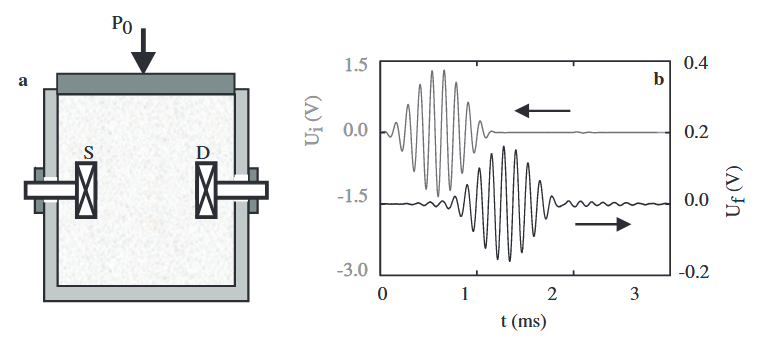
(a) Schematic of the experimental setup where glass beads are confined by a vertical stress of $P = 40\text{ kPa}$. Compressional waves are excited by a source transducer S and detected by a second transducer $D$. (b) A typical input wave $U_{i}$ consisting of a ten-cycle Gaussian tone burst centered at $f = 9\text{ kHz}$ (top, grey) and the transmitted wave $U_{f}$ (bottom, black).
(a) 实验装置示意图,玻璃珠受限于垂直应力 $P = 40\text{ kPa}$。压缩波由源换能器 S 激发,并由第二个换能器 $D$ 检测。 (b) 典型的输入波形 $U_{i}$,包括以 $f = 9{ kHz}$ 为中心的十周期高斯音脉冲串(上图,灰色)和传输波形 $U_{f}$(下图,黑色)。
We send ten-cycle Gaussian tone bursts centered at a low frequency (in the $8–10\text{ kHz}$ range) every $50\text{ ms}$. The obtained data averaged over ~ $1\text{ s}$ allows us to simultaneously measure the sound velocity $V$ and the magnitude and harmonic content of the transmitted signal.
我们每隔 $50\text{ ms}$ 发送一次以低频($8–10\text{ kHz}$ 范围内)为中心的十周期高斯音脉冲列。在 ~ $1\text{ s}$ 范围内平均获得的数据使我们能够同时测量声速 $V$ 以及传输信号的幅度和谐波含量。
The sound velocity was determined from the time-of-flight velocity $V$ between the excitation and the transmitted Gaussian pulses (fig. 1(b)) —no appreciable dispersion of the sound velocity was observed in the frequency range $1–100\text{ kHz}$.
声速是根据激发脉冲和传输高斯脉冲之间的飞行时间速度 $V$ 确定的(图 1(b))–在频率范围 $1-100\text{ kHz}$ 内没有观察到明显的声速频散。
We note here that typical wavelengths are of order $1\text{ cm}$, smaller than the detector, but significantly larger than the beads, so that our sound waves probe the granular medium at an intermediate scale.
我们在此注意到,典型的波长为 $1\text{ cm}$,比探测器小,但比珠子大得多,因此我们的声波可以在中间尺度上探测颗粒介质。
We characterize the transmitted signal by the amplitude of the fundamental component and the second harmonic. To do so, we filter the detected waves in the time domain using custom written Labview routines, and determine the amplitudes $U_{f}$ of the fundamental and $U_{2f}$ of the second harmonic by fitting Gaussian profiles to the appropriately filtered signal. This allows us to probe the evolution of $V$, $U_{f}$ and $U_{2f}$ as a function of the input amplitude $U_{i}$ and time $t$.
我们通过基波分量和二次谐波的振幅来描述传输信号的特征。为此,我们使用定制的 Labview 程序对检测到的波进行时域滤波,并通过对适当滤波后的信号进行高斯轮廓拟合,确定基波的振幅 $U_{f}$ 和二次谐波的振幅 $U_{2f}$。这样,我们就能探测到 $V$、$U_{f}$ 和 $U_{2f}$ 的演变与输入振幅 $U_{i}$ 和时间 $t$ 的函数关系。
Strengthening and weakening of compressed samples
We probe the evolution of the granular medium under the influence of nonlinear sound by measuring both the amplitude and time-of-flight velocity of the transmitted acoustic signal as a function of time. We first focus on our well-compressed sample ($P = 40\text{ kPa}$), using ten-cycle pulses centered at $8\text{ kHz}$ and fixing $U_{i} = 90\text{ mV}$, corresponding to a vibration displacement of about $10\text{ nm}$ (acceleration $2–3 g$).
我们通过测量传输声学信号的振幅和飞行速度与时间的函数关系,来探究颗粒介质在非线性声学影响下的演变。我们首先关注压缩良好的样品 ($P = 40\text{ kPa}$),使用以 $8\text{ kHz}$ 为中心的十周期脉冲,并固定 $U_{i} = 90\text{ mV}$,相当于约 $10\text{ nm}$ 的振动位移(加速度为 $2-3 g$)。
这里的加速度是指的什么?
As figs. 2(a), (b) illustrate, both the velocity $V$ and the ratio $U_{f}/U_{i}$ show a significant time evolution, even as the input strength is kept constant: the granular packing is modified by the sound waves. We stress that the evolution of the amplitude ratio and the sound velocity appear very similar.
如图 2(a)和(b)所示,即使输入强度保持不变,速度 $V$ 和比率 $U_{f}/U_{i}$ 都显示出显著的时间演变:颗粒堆积被声波改变。我们强调,振幅比和声速的演变非常相似。
Surprisingly, this evolution is not always monotonic: In the experiments shown in figs. 2(a),(b), both amplitude and velocity of the transmitted wave increase from $0$ to $3000\text{ s}$, corresponding to a strengthening of the granular packing, whereas from $3000$ to $8000\text{ s}$, the amplitude and the velocity decreased, implying a weakening of the granular packing.
令人惊讶的是,这种演变并不总是单调的:在图 2(a)和(b)所示的实验中,从 $0$ 到 $3000\text{ s}$,传输波的振幅和速度都在增加,这与颗粒堆积的增强相对应;而从 $3000$ 到 $8000\text{ s}$,振幅和速度都在减小,这意味着颗粒堆积的减弱。
During the experiment, we do not observed any visible rearrangement of the grains or measure any significant change in the height of the granular sample. We estimate the maximal change in the height to be less than $10\text{ }\mu\text{m}$, corresponding to a change in packing fraction less than $0.1\%$. This is significantly less from density changes seen in tapping experiments, and far too small to explain by itself the observed evolution of our packings.
在实验过程中,我们没有观察到任何可见的颗粒重新排列,也没有测量到颗粒样品高度的任何显著变化。我们估计高度的最大变化小于 $10{}\mu\text{m}$,对应的堆积分数变化小于 $0.1%$。这与 Tapping 实验中看到的密度变化相差甚远,而且这种变化太小,无法解释我们观察到的堆积演化。
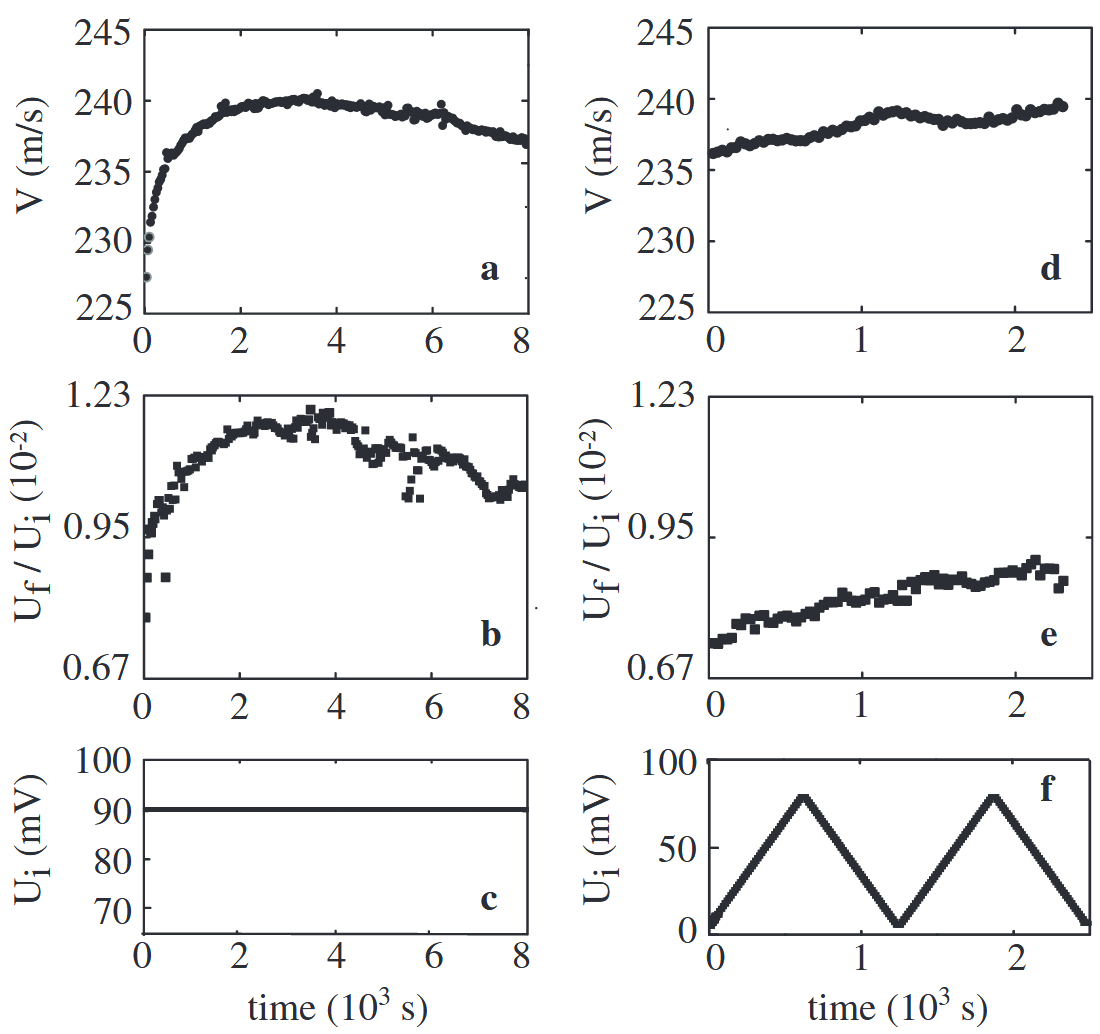
Interaction of high-amplitude sound waves with a bead packing under $P = 40\text{ kPa}$. (a)–(c) Constant input; (d)–(f) sweeps. (a), (d): evolution of sound velocity $V$ . (b), (e): evolution of the ratio of transmitted first harmonic, $U_{f}$ , and input $U_{i}$. (c), (f): $U_{i}$.
在 $P = 40\text{ kPa}$ 条件下高振幅声波与球珠堆积的相互作用。(a)-(c) 恒定输入;(d)-(f) 扫频。(a)、(d):声速 $V$ 的演变。 (b)、(e):传输的第一次谐波 $U_{f}$ 与输入 $U_{i}$ 的比率的演变。(c), (f): $U_{i}$。
To probe the role of the excitation amplitude, we performed similar acoustic measurements by ramping the input amplitude $U_{i}$ up and down. As figs. 2(d)–(f) illustrate, the strengthening or weakening does not simply correlate to an increase or decrease of the excitation amplitude as would be expected for solitonic or shock waves the observed changes in transmission and sounds speed are not simply due to such nonlinear effects, but rather suggest an evolution of the packing.
为了探究激励振幅的作用,我们通过上下调节输入振幅 $U_{i}$ 进行了类似的声学测量。如图图 2(d)-(f) 表明,增强或减弱与激发振幅的增大或减小并不简单相关,正如对孤音波或冲击波所预期的那样。
Repeating these experiments, both with fixed and varying $U_{i}$, and for different sweep rates, we did not find a clear correlation between the excitation protocol and the strengthening or weakening behavior, although we note that immediately after loading the initial behavior is always strengthening.
重复这些实验,无论是固定还是改变 $U_{i}$,以及不同的扫描速率,我们都没有发现激励协议与强化或弱化行为之间存在明显的相关性,尽管我们注意到加载后的初始行为总是强化的。
Strengthening and weakening of weakly compressed samples
The time evolution of our granular samples must be caused by microscopic changes in the contact fabric, which we expect to be more easily excited at lower pressures. We conducted a second series of experiments in a packing of glass beads under gravity, and focus on the protocol where $U_{i}$ is ramped up and down. We undertook a total of $21$ runs.
颗粒样品的时间演化一定是由接触结构的微观变化引起的,我们预计这种变化在较低压力下更容易被激发。我们在重力作用下的玻璃珠堆积中进行了第二系列实验,重点研究了令 $U_{i}$ 升高和降低的协议。我们总共进行了 $21$ 次实验。
As fig. 3 illustrates, we observe three distinct types of behavior: strengthening (fig. 3(a), 9 times), weakening (fig. 3(b), 8 times), or, more rarely, random variation between strengthening and weakening (fig. 3(c), 4 times). The random nature of the weakening or strengthening confirms that the type of evolution is not only controlled by the sound amplitude, but also depends on the history and particular microstate of the granular packing itself.
We note that the sound velocity variation observed at this low pressure is about $10\%$, larger than the 4% observed at higher pressures (P = 40 kPa), consistent with our expectation that lower pressures promote the evolution of the packing.
如图 3 所示,我们观察到三种不同类型的行为:增强(图 3(a),$9$ 次)、减弱(图 3(b),$8$ 次),或更罕见的增强和减弱之间的随机变化(图 3(c),$4$ 次)。弱化或强化的随机性证实,演变类型不仅受声幅控制,还取决于颗粒堆积本身的历史和特定微观状态。
我们注意到,在这种低压下观察到的声速变化约为 $10\%$,大于在较高压力($P = 40\text{ kPa}$)下观察到的 $4\%$,这与我们的预期一致,即较低的压力会促进堆积的演化。
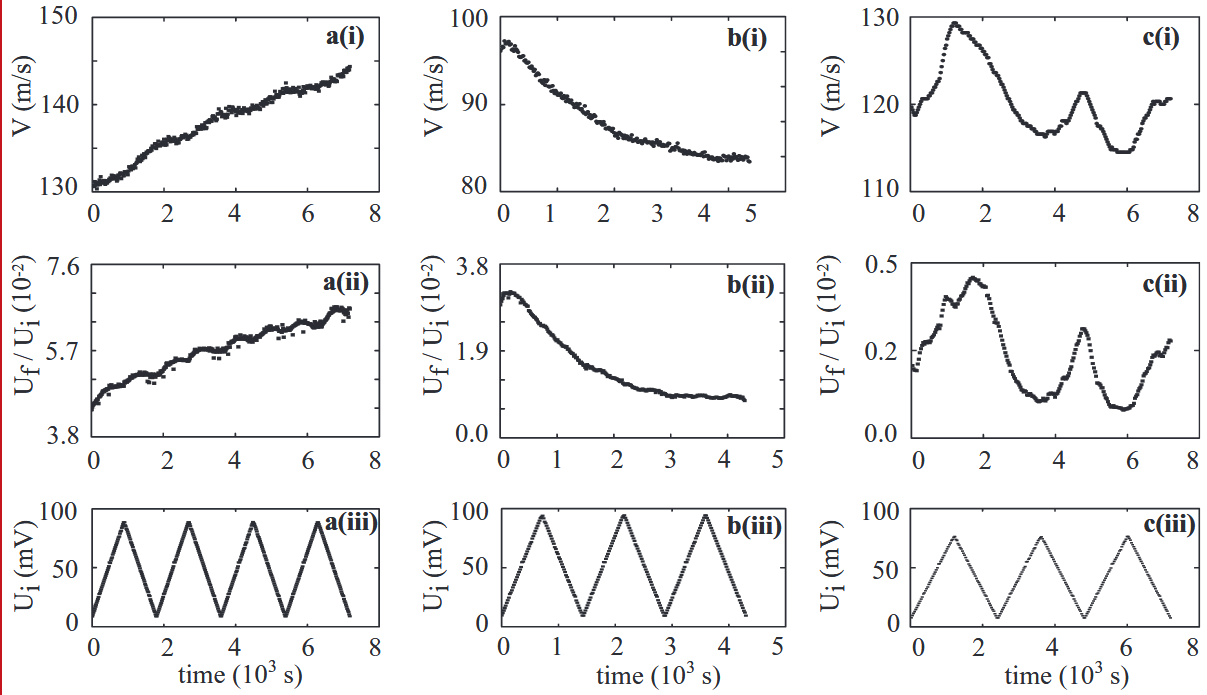
Typical measurements of the sound velocity (i) and the amplitude ratio (ii) measured as a function of time in a loose granular packing under $P = 2\text{ kPa}$, excited by a given protocol (iii). Three distinct regimes are observed: (a) strengthening, (b) weakening, and (c) interplay between strengthening and weakening.
声速的典型测量值 (i) 和振幅比 (ii) 作为时间函数在 $P = 2\text{ kPa}$ 下的松散颗粒堆积中测量,由给定的协议 (iii) 激发。可以观察到三种不同的状态:(a) 强化,(b) 弱化,(c) 强化和弱化之间的相互作用。
The striking similarity that we observed between the temporal variations in the amplitude ratio and in the sound velocity can be qualitatively understood in terms of the acoustic impedance using an effective medium approach, as follows: The acoustic impedance of the granular material is $z_{g} ≔ \rho V$ , where $\rho$ and $V$ are the mediums density and the effective sound velocity, and the transducers have a much higher impedance $z_{t}$. The coefficient of amplitude transmission for a plane wave from the source transducer to the granular medium is given by $t_{1} = 2z_{t}/(z_{t} + z_{g})$, whereas the transmission coefficient from the granular medium to the detection transducer $t_{2} = 2z_{g}/(z_{t} + z_{g})$, so that the coefficient of the total transmission $t$ is thus
$$ t = t_{1}t_{2} = \frac{4z_{g}z_{t}}{(z_{g} + z_{t})^{2}} \approx \frac{4z_{g}}{z_{t}} \approx \rho V.\tag{1}\label{eq1} $$
我们所观察到的振幅比和声速的时间变化之间的惊人相似性,可以用有效介质方法从声阻抗的角度定性地理解如下:颗粒材料的声阻抗为 $z_{g} ≔ \rho V$,其中 $\rho$ 和 $V$ 分别为介质密度和有效声速,而传感器的阻抗 $z_{t}$ 要高得多。从声源换能器到颗粒介质的平面波振幅传输系数为 $t_{1} = 2z_{t}/(z_{t} + z_{g})$,而从颗粒介质到探测换能器的传输系数为 $t_{2} = 2z_{g}/(z_{t} + z_{g})$,因此总传输系数 $t$ 为
$$ t = t_{1}t_{2} = \frac{4z_{g}z_{t}}{(z_{g} + z_{t})^{2}} \approx \frac{4z_{g}}{z_{t}} \approx \rho V. $$
Since we did not measure a significant change in the height of the granular sample, we argue that the packing density $\rho$ remains almost constant, so that it follows that in this framework, the amplitude of sound transmission should be linearly proportional to the sound velocity.
由于我们没有测量到颗粒样本高度的明显变化,我们认为堆积密度 $\rho$ 几乎保持不变,因此在此框架下,声音传播的振幅应与声速成线性比例。
While this is qualitatively consistent with our observations, we note here that the variation in amplitude is much stronger than the variation in sound velocity — for example, in fig. 3(b), the change in $V$ is of order $15\%$, whereas the change in $U_{f}/U_{i}$ is more than a factor $2!$ Comparing the changes in $V$ and $U_{f}/U_{i}$ of all our data, we conclude that the typical change in transmission amplitude is roughly five times larger than the change in velocity. This suggest that effective medium theory can not quantitatively account for the evolution of the packing by nonlinear sound waves: the physics underlying the evolution of the packing is truly complex.
虽然这与我们的观测结果在本质上是一致的,但我们在此注意到,振幅的变化要比声速的变化大得多–例如,在图 3(b) 中,$V$ 的变化量级为 $15\%$,而 $U_{f}/U_{i}$ 的变化量级则超过了系数 2!$。比较所有数据中 $V$ 和 $U_{f}/U_{i}$ 的变化,我们得出结论:传输振幅的典型变化大约是速度变化的五倍。这表明,有效介质理论无法定量解释非线性声波对堆积物的影响:堆积物演化的物理基础确实非常复杂。
Harmonic generation
On the scale of the grain contacts, two types of nonlinearity can be distinguished: one arises from the normal loading (Hertzian model) and the other from the tangential friction force (Mindlin model).
在颗粒接触的尺度上,可以区分出两种非线性:一种来自法向载荷(Hertz 模型),另一种来自切向摩擦力(Mindlin 模型)。
It is useful to distinguish a weakly and strongly nonlinear regime, by the relative magnitude of the sound amplitude $u$ and the typical static grain deformation $u_{0}$, induced by the confining pressure. The highly nonlinear regime corresponds to $u\gg u_{0}$, shock waves can be generated with a front velocity depending on the wave amplitude, strongly damped by plastic rearrangement and frictional dissipation.
根据声振幅 $u$ 和约束压力引起的典型静态颗粒变形 $u_{0}$ 的相对大小,可以区分弱非线性和强非线性体系。高度非线性机制对应于 $u\gg u_{0}$,冲击波可以产生与波幅相关的前速度,并受到塑性重排和摩擦耗散的强烈阻尼。
On the other hand, in the weakly nonlinear regime ($u\ll u_{0}$), reversible nonlinear responses described by the nonlinear terms of the normal stiffness have been observed, including second-harmonic generation.
另一方面,在弱非线性机制($u\ll u_{0}$)中,观察到了由法向刚度的非线性项描述的可逆非线性响应,包括二次谐波的产生。
To gain more insight into the microscopics underlying the strengthening and weakening, we have probed the magnitude of the second harmonic. As we will detail below, the Hertzian nonlinearity in the normal forces, associated with changes in the particles overlap, will give rise to second-harmonic generation, with a magnitude $U_{2f}$ that is expected to rise as $U_{i}^{2}$.
为了更深入地了解强化和弱化的微观基础,我们对二次谐波的大小进行了探测。正如我们将在下文详述的那样,法向力中的 Hertzian 非线性与颗粒重叠的变化有关,会产生二次谐波,其大小 $U_{2f}$ 预计会随着 $U_{i}^{2}$ 的上升而上升。
In contrast, nonlinearities due to sliding or transversal motion of contacting grains, described by the full Hertz-Mindlin interactions, do not generate second harmonics, due to symmetry (“sliding left is equivalent to sliding right”). Our central finding is a one-to-one correlation between strengthening and the generation of second harmonics on the one hand, and weakening and the absence of second harmonics, on the other hand.
与此相反,由于对称性(“向左滑动等同于向右滑动”),由接触晶粒的滑动或横向运动引起的非线性(由完全的 Hertz-Mindlin 相互作用描述)不会产生二次谐波。我们的核心发现是,一方面加强与产生二次谐波之间存在一一对应关系,另一方面减弱与不产生二次谐波之间也存在一一对应关系。
To correlate strengthening/weakening and second- harmonic generation, we focus on all $17$ data sets taken at $2\text{ kPa}$ that monotonically weaken or strengthen. As figs. 4(a), (b) illustrate, we first will study scatter plots of $U_{2f}$ vs. $U_{i}$.
为了将增强/减弱与二次谐波的产生联系起来,我们重点研究了在 $2\text{ kPa}$ 时单调减弱或增强的所有 $17$ 数据集。如图 4(a), (b) 所示,我们首先将研究 $U_{2f}$ vs. $U_{i}$ 的散点图。
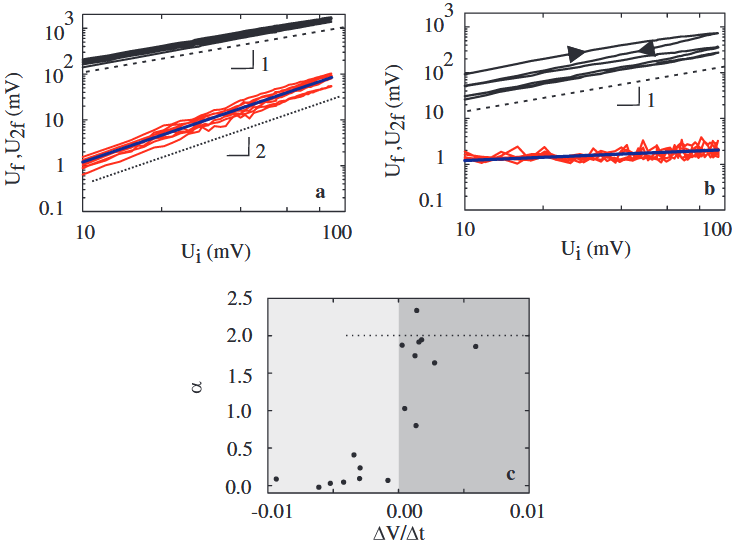
Second-harmonic generation measured in the packings of fig. 3. (a) The fundamental $U_{f}$ (black circles) and second harmonic $U_{2f}$ (red crosses) measured vs. $U_{i}$ during strengthening. Linear and quadratic scaling (dashed and dotted lines) are shown as a guide to the eye. (b) $U_{f}$ (black circles) and second harmonic $U_{2f}$ (red crosses) measured vs. $U_{i}$ during weakening. The straight blue line corresponds to the best fit. (c) Scatter plot of power law exponent $\alpha$ vs. $\Delta V /\Delta t$ for $U_{2f}$ shows that $\alpha\approx 2$ for strengthening samples (dark-grey shade), whereas $\alpha\approx 0$ for weakening samples (light-grey shade). Error bars on $\alpha$ are or order $20\%$.
在图 3 堆积中测量到的二次谐波产生。 (a) 强化过程中测得的基波 $U_{f}$(黑圆圈)和二次谐波 $U_{2f}$(红叉)与 $U_{i}$的关系。图中显示了线性和二次缩放(虚线和点线),以方便观察。 (b) 在弱化过程中测量到的 $U_{f}$(黑圆圈)和二次谐波 $U_{2f}$(红叉)与 $U_{i}$的关系。蓝色直线为最佳拟合值。 (c) $U_{2f}$ 的幂律指数 $\alpha$ vs. $\Delta V /\Delta t$ 的散点图显示,对于增强的样品(深灰色阴影),幂律指数 $\alpha\approx 2$,而对于减弱的样品(浅灰色阴影),幂律指数 $\alpha\approx 0$。关于 $\alpha$ 的误差条数为 $20%$。
Let us first focus on fig. 4(a) which shows harmonic generation for a strengthening sample (the same as depicted in fig. 3(a)). Here, the second-harmonic $U_{2f}$ grows quadratically with $U_{i}$. We show now that this is consistent with the Hertzian nonlinearity of the normal forces between grains, where the contact force $F$ between two particles scales as $\delta^{3/2}$, where $\delta$ is the particles deformation. Here, $\delta$ is composed of two contributions: a constant $\delta_{0}$, which in a mean-field approximation is set by the pressure, and an oscillation contribution $u_{n}$, which is due to the sound wave.
让我们首先关注图 4(a),图 4(a) 显示了一个受强化样品(与图 3(a)中描述的相同)的谐波产生情况。在这里,二次谐波 $U_{2f}$ 与 $U_{i}$ 成二次增长。我们现在要说明的是,这与颗粒间法向力的 Hertzian 非线性是一致的,即两个颗粒间的接触力 $F$ 以 $\delta^{3/2}$ 的形式缩放,其中 $\delta$ 是颗粒的变形量。在这里,$\delta$ 由两个贡献组成:一个是常数 $\delta_{0}$,在平均场近似中由压力设定;另一个是振荡贡献 $u_{n}$,由声波引起。
Expanding the Hertzian contact law around $\delta = \delta_{0}$, we find that the oscillating component of the force between particles $F_{n}\approx D_{n}u_{n}(1 + \beta u_{n} + \delta u_{n}^{2} + \dots)$, where $D_{n}$ is the linear normal stiffness, and $\beta$ and $\delta$ correspond to the quadratic and cubic nonlinear terms determined by the confining pressure $P$. From this, we can obtain an approximate expression for the second-harmonic displacement within effective medium approaches $U_{2f}\propto \beta f^{2}U_{i}^{2}$, which is precisely the power law observed in fig. 4(a).
围绕 $\delta = \delta_{0}$ 展开 Hertzian 接触定律,我们发现粒子间力的振荡分量 $F_{n}\approx D_{n}u_{n}(1 + \beta u_{n} + \delta u_{n}^{2} + \dots)$, 其中 $D_{n}$ 是线性法向刚度,$\beta$ 和 $\delta$ 分别对应于由约束压力 $P$ 决定的二次方和三次方非线性项。由此,我们可以得到有效介质内二次谐波位移的近似表达式 $U_{2f}\propto \beta f^{2}U_{i}^{2}$ ,这正是图 4(a) 中观察到的幂律。
Let us now turn to fig. 4(b), which shows the absence of significant second-harmonic generation in a weakening sample. Clearly, the magnitude of the normal relative motion un is too small to excite a significant second harmonic, but nevertheless, the amplitude of the sound wave is similar — what is going on? We suggest that in this case, the relative motion between particles is mainly in the perpendicular, sliding direction.
现在让我们来看图 4(b),它显示了在减弱的样品中没有明显的二次谐波产生。显然,法向相对运动的振幅太小,不足以激发明显的二次谐波,但声波的振幅却相似–这是怎么回事呢?我们认为,在这种情况下,粒子之间的相对运动主要是在垂直的滑动方向上。
垂直+滑动 ?是什么意思?
We may deduce from the Mindlin theory an approximate relation between the shear oscillating displacement $u_{t}$ and force $F_{t}$, $u_{t}\approx S_{t}F_{t} + \gamma F_{t}^{3} + \dots$, where $S_{t}$ is the nonlinear dynamic compliance and $\gamma$ the cubic nonlinear term. The absence of a quadratic nonlinear term is due to symmetry, which implies that nonlinear effects like harmonics generation are one order smaller than for the normal oscillation, and would explain the absence of an appreciable second harmonic in the weakening regime shown in fig. 4(b).
我们可以从 Mindlin 理论中推导出剪切振荡位移 $u_{t}$ 与力 $F_{t}$ 之间的近似关系,即 $u_{t}\approx S_{t}F_{t}+ \gamma F_{t}^{3}+ \dots$,其中 $S_{t}$ 是非线性动态顺应性,$\gamma$ 是三次非线性项。没有二次非线性项是由于对称性,这意味着谐波产生等非线性效应比正常振荡小一个数量级,这也解释了图 4(b) 所示的弱化机制中没有明显二次谐波的原因。
The generality of the link between strengthening/weakening and second-harmonic generation is illustrated in fig. 4(c). Here we have characterized all data sets (not just those shown in figs. 4(a) and (b)) by the overall time evolution of the sound velocity, $\Delta V /\Delta t$, and an exponent $\alpha$, obtained by fitting a power law expression of the form $U_{2f} = AU_{i}^{\alpha}$ to the scatter plots of $U_{2f}$ vs. $U_{i}$. fig. 4(c) shows the resulting scatter plot of the exponent $\alpha$ as a function of $\Delta V /\Delta t$.
图 4(c)说明了增强/减弱与二次谐波产生之间联系的普遍性。在这里,我们对所有数据集(不仅仅是图 4(a)和(b)中所示的)进行了表征,即声速的全局时间演变($\Delta V /\Delta t$)和指数 $\alpha$,该指数是通过拟合 $U_{2f}$ 与 $U_{i}$ 的散点图,得到的幂律表达式为 $U_{2f} = AU_{i}^{\alpha}$ 。图 4(c) 显示了指数 $\alpha$ 与 $\Delta V /\Delta t$ 的函数关系的散点图。
Clearly, the exponent goes from a value around zero (for $\Delta V /\Delta t < 0$) to a value around two (for $\Delta V /\Delta t > 0$). Even though the drift in sound velocity is not linear, this shows that $\Delta V /\Delta t$ captures the sign of this drift, i.e., strengthening vs. weakening.
很明显,指数值从 $0$($\Delta V /\Delta t < 0$)到 $2$($\Delta V /\Delta t > 0$)。尽管声速值的移动并非线性,但这表明 $\Delta V /\Delta t$ 捕捉到了这种漂移的符号,即 增强 vs. 减弱。
Figure 4(c) thus illustrates the generality of our finding that for strengthening samples, the second harmonic $U_{2f}$ grows quadratically with $U_{i}$, consistent with a simple Hertzian nonlinearity, whereas for weakening samples, $U_{2f}$ is small and nearly independent of $U_{i}$, suggesting that in the weakening regime the Hertzian nonlinearity is not dominant and likely overshadowed by the frictional nonlinearity.
因此,图 4(c) 说明了我们发现的普遍性:对于增强样品,二次谐波 $U_{2f}$ 与 $U_{i}$ 成二次增长,这与简单的 Hertzian 非线性一致;而对于减弱样品,$U_{2f}$ 较小,几乎与 $U_{i}$ 无关,这表明在减弱机制中,Hertzian 非线性并不占主导地位,很可能被摩擦非线性所掩盖。
Finally, we have revisited the limited number of runs that show alternating strengthening and weakening, and have inspected the magnitude of the second harmonic. We note that when a sample switches from strengthening to weakening, the second harmonic does not drop immediately, suggesting that the harmonic generation follows, and not precedes, the strengthening or weakening of the sample.
最后,我们重新审视了有限的几次实验(这些实验显示出增强和减弱的交替), 并检查了二次谐波的大小。我们注意到,当样本从增强转为减弱时,二次谐波不会立即下降,这表明谐波的产生是在样本增强或减弱之后,而不是之前。
Evolution of harmonics
During strengthening, the packing continues to evolve over several sweeps of $U_{i}$. As shown in fig. 5, the second harmonic $U_{2f}$ also keeps growing in strength. This growth is not only simply due to $U_{i}$ becoming larger — by plotting the ratio of $U_{2f}/U_{f}$ as a function of $U_{i}$, we find that also this ratio increases over time, indicating that the generation of the second harmonics becomes more efficient as the sample strengthens. Again, this evidences the complexity of the evolution of the granular packing.
在强化过程中,堆积会在 $U_{i}$ 的几次扫描中继续演变。如图 5 所示,二次谐波 $U_{2f}$ 的强度也在持续增长。这种增长不仅仅是由于 $U_{i}$ 变大,通过绘制 $U_{2f}/U_{f}$ 与 $U_{i}$ 的比率,我们发现这一比率也会随着时间的推移而增加,这表明随着样本的增强,二次谐波的生成变得更加有效。这再次证明了颗粒堆积演变的复杂性。
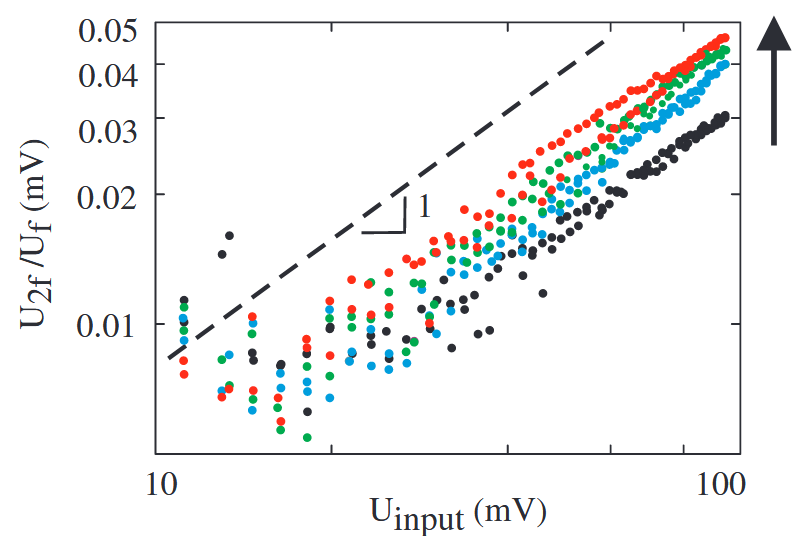
Amplitude ratio between the second harmonic and fundamental component of fig. 4(a), obtained during the sequential excitation cycles: 1st cycle up-down (black), 2nd cycle up-down (blue), 3rd cycle up-down (green) and 4th cycle up-down (red). The second-harmonic generation increases with the number of cycles, as indicated by the arrow.
图 4(a) 中二次谐波和基波分量之间的振幅比,在连续激励周期中获得:第 1 个周期的起伏(黑色),第 2 个周期起伏(蓝色),第 3 个周期起伏(绿色),第 4 个周期起伏(红色)。如箭头所示,二次谐波的产生随周期数的增加而增加。
Discussion and conclusion
Our data of the trans- mission of nonlinear sound pulses in weakly compressed granular packings reveals strong evolution of the velocity and amplitude of these pulses as well as its harmonic generation. A simple effective medium picture captures the correlation between weakening/strengthening of sound velocity and transmission amplitude qualitatively, but fails to quantitatively capture the magnitude of these effects.
我们关于非线性声脉冲在弱压缩颗粒堆积中传播的数据显示,这些脉冲的速度和振幅以及谐波的产生都发生了强烈的变化。简单的有效介质绘景可以定性地捕捉到声速减弱/增强与传输振幅之间的相关性,但无法定量地捕捉到这些效应的大小。
Similarly, the generation of second harmonics in the strengthening regime is consistent with the Hertzian nonlinearity of the normal force components, but this nonlinearity itself is not sufficient to capture the magnitude of strengthening/weakening.
同样,在强化过程中产生的二次谐波与法向力分量的 Hertzian 非线性是一致的,但这种非线性本身并不足以反映强化/减弱的程度。
We suggest that changes in the contact number $Z$ are an essential step towards understanding the magnitude of the observed strengthening and weakening phenomena. Based on the coincidence of an increase of sound velocity and transmission amplitude with second-harmonic generation, we conjecture the following picture (see fig. 6).
我们认为,接触数 $Z$ 的变化是理解所观察到的增强和减弱现象的重要一步。根据声速和传播振幅的增加与二次谐波产生的巧合,我们推测会出现以下情况(见图 6)。
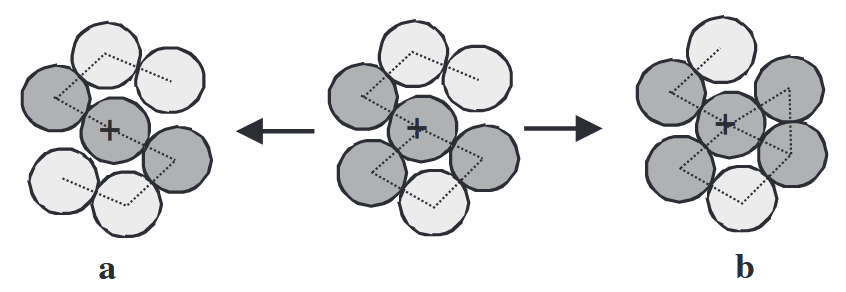
Schematic illustrations of sound-induced change in the mechanical coordination number: (a) a decrease via acoustic fluidization; (b) an increase via buckling. The associated packing density and geometric coordination number remain unchanged in all these cases.
由声音引起的机械配位数变化示意图:(a)通过声学流化减少;(b)通过屈曲增加。在所有这些情况下,相关的堆积密度和几何配位数保持不变。
In the weakening regime, the tangential vibration between jammed particles reduces the contact stiffness $D_{t}$ via the frictional nonlinearity and further causes the loss of contacts via sliding of particles out of contact $\Delta Z < 0$ (fig. 6(a)), a process previously refereed to as acoustic fluidization. Since the frictional nonlinearity does not generate even harmonics, this is consistent with the observed absence of second harmonics in the weakening regime (fig. 4).
在弱化机制中,被堵塞颗粒之间的切向振动通过摩擦非线性降低了接触刚度 $D_{t}$,并通过颗粒滑动脱离接触进一步导致接触损失 $\Delta Z < 0$(图 6(a)),这一过程之前被称为声学流化。由于摩擦非线性不会产生偶次谐波,这与观察到的弱化机制中没有二次谐波是一致的(图 4)。
In contrast, in the strengthening regime, large normal vibrations take place (as evidenced by the observed generation of second harmonics), and these vibrations lead to buckling of the force chains — a dynamic counterpart of pressure-induced particle buckling. This mechanism would result in the formation of new contacts involved in the force chains $\Delta Z > 0$ (fig. 6(b)), driving the system to a mechanically more stable configuration. Note that this mechanism is different from the particle buckling mechanism induced by compression, which is accompanied with a packing fraction change.
与此相反,在强化系统中,会发生较大的法向振动(观察到的二次谐波的产生就是证明),这些振动会导致力链屈曲–这是压力诱导的粒子屈曲的动态对应物。这种机制会导致力链中形成新的接触点($\Delta Z > 0$)(图 6(b)),从而使系统达到机械上更稳定的构型。请注意,这种机制不同于压缩引起的粒子屈曲机制,后者伴随着堆积分数的变化。
While in frictional packings, changes in the overall contact number $Z$ may arise without appreciable changes of the packing fraction, we believe that such contact changes, although important, only capture part of the physics: First, according to effective medium theory, the measured variation of the sound velocity $\Delta V /V\sim 10\%$ (fig. 3) would correspond to $\Delta Z/Z\approx 3\delta V /V\sim 30\%$, close to a relative variation between random close packing ($Z_{\text{RCP}}\approx 6$) and random loose packing ($Z_{\text{RLP}}\approx 4$).
虽然在含摩擦堆积中,整体接触数 $Z$ 的变化可能不会引起堆积分数的显著变化,但我们认为,这种接触变化虽然重要,但只捕捉到了物理学的一部分: 首先,根据有效介质理论,测得的声速变化 $\Delta V /V\sim 10%$ (图 3)将对应于 $\Delta Z/Z\approx 3\delta V /V\sim 30\%$ ,接近于随机紧密堆积($Z_{\text{RCP}}\approx 6$)和随机松散堆积($Z_{\text{RLP}}\approx 4$)之间的相对变化。
It is unlikely that such large changes in the contact number can arise without appreciable changes in the packing fraction. Second, changes in the contact number alone do not capture the discrepancy between the typical variation in the sound velocity and the transmission amplitude —recall that the change in the latter is typically five times larger than the change in the former. Both of these observations illustrate that the effective medium theory qualitatively describes the experiments, but fails to quantitatively account for the data. We suggest that the changes in contact numbers lead to significant rearrangements of the contact network, which eventually result in the breakdown of the affine approximations underlying EMT.
接触数发生如此大的变化,而堆积分数却没有明显变化,这是不可能的。其次,仅凭接触数的变化并不能捕捉到声速和透射振幅典型变化之间的差异–注意后者的变化通常是前者变化的五倍。这两点说明,有效介质理论可以定性地描述实验,但无法定量地解释数据。我们认为,接触数的变化会导致接触网络的明显重排,最终导致 EMT 所依据的仿射近似的破坏。
Our experiments therefore evidence evolution of the packing beyond what can be captured by effective medium theories. Important questions raised by this work then include, first, what causes the system to collectively strengthen or weaken and, second, what models can quantitatively capture the large variation in sound velocity and sound transmission observed.
因此,我们的实验证明了堆积的演变超出了有效介质理论所能描述的范围。因此,这项工作提出的重要问题包括:首先,是什么导致了系统的集体增强或减弱;其次,什么模型可以定量地描述所观察到的声速和声音传播的巨大变化。

